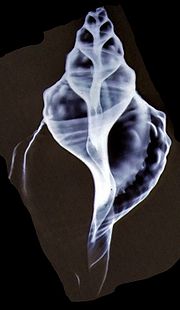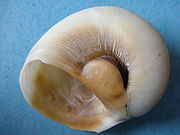
Umbilicus (mollusk)
Encyclopedia

Mollusc shell
The mollusc shell is typically a calcareous exoskeleton which encloses, supports and protects the soft parts of an animal in the phylum Mollusca, which includes snails, clams, tusk shells, and several other classes...
is the axially aligned, hollow cone-shaped space within the whorls
Whorl (mollusc)
A whorl is a single, complete 360° revolution or turn in the spiral growth of a mollusc shell. A spiral configuration of the shell is found in of numerous gastropods, but it is also found in shelled cephalopods including Nautilus, Spirula and the large extinct subclass of cephalopods known as the...
of a coiled mollusc shell. The term umbilicus is often used in descriptions of gastropod
Gastropoda
The Gastropoda or gastropods, more commonly known as snails and slugs, are a large taxonomic class within the phylum Mollusca. The class Gastropoda includes snails and slugs of all kinds and all sizes from microscopic to quite large...
shells, i.e. it is a feature present on the ventral (or under) side of many (but not all) snail
Snail
Snail is a common name applied to most of the members of the molluscan class Gastropoda that have coiled shells in the adult stage. When the word is used in its most general sense, it includes sea snails, land snails and freshwater snails. The word snail without any qualifier is however more often...
shells, including some species of sea snails, land snails, and freshwater snails.
The word is also applied to the depressed central area on the planispiral coiled shells of Nautilus
Nautilus
Nautilus is the common name of marine creatures of cephalopod family Nautilidae, the sole extant family of the superfamily Nautilaceae and of its smaller but near equal suborder, Nautilina. It comprises six living species in two genera, the type of which is the genus Nautilus...
species and fossil ammonites. (These are not gastropods, but shelled cephalopods.)
In gastropods

Another way of characterizing the umbilicus in gastropods is as the hole around which the inner surface of the shell is coiled, when that space is not filled by a columella.
In species
Species
In biology, a species is one of the basic units of biological classification and a taxonomic rank. A species is often defined as a group of organisms capable of interbreeding and producing fertile offspring. While in many cases this definition is adequate, more precise or differing measures are...
with a wide, open umbilicus, such as the heath snail (Helicella itala
Helicella itala
Helicella itala is a species of medium-sized, air-breathing land snail, a terrestrial pulmonate gastropod mollusk in the family Hygromiidae, the hairy snails and their allies.- Life cycle :The size of the egg is 1.5 mm....
), the spiral of the whorls can be clearly viewed by looking into the umbilicus.
An umbilicus can vary from very narrow and punctured, as found in Petasina unidentata
Petasina unidentata
Petasina unidentata is a species of air-breathing land snail, a terrestrial pulmonate gastropod mollusk in the family Hygromiidae, the hairy snails and their allies....
, to wide and shallow, such as the deep and wide depression in the rounded snail (Discus rotundatus
Discus rotundatus
Discus rotundatus is a species of small, air-breathing, land snail, a terrestrial pulmonate gastropod mollusk in the family Discidae, the disk snails.-Distribution:...
). Shells with a conspicuous umbilicus are always orthostylic, i.e. they have a poorly developed columella.
Sometimes there is a dimple or funnel-shaped depression, known as the umbilical region or the umbilical field, next to or at the basal hollow of the columella, when the walls of successive whorls are not closely wound against each other.
A phaneromphalous shell has an open umbilicus. A cryptomphalous shell has the opening of the umbilicus completely plugged.
 |
In cephalopods
 |
 |

